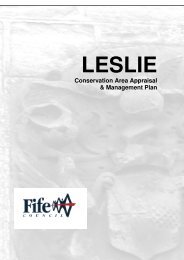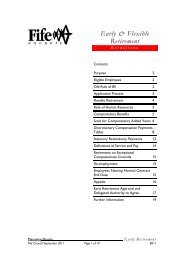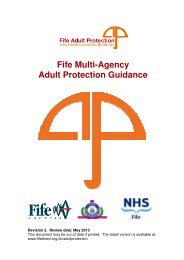An Economic Profile of the Glenrothes Area - Home Page
An Economic Profile of the Glenrothes Area - Home Page
An Economic Profile of the Glenrothes Area - Home Page
You also want an ePaper? Increase the reach of your titles
YUMPU automatically turns print PDFs into web optimized ePapers that Google loves.
<strong>An</strong> <strong>Economic</strong> <strong>Pr<strong>of</strong>ile</strong> <strong>of</strong> <strong>the</strong> Glenro<strong>the</strong>s <strong>Area</strong>December 2011Enterprise, Planning and Protective Services
TABLE OF CONTENTSINTRODUCTION................................................................................................................2GLENROTHES AREA COMMITTEE BOUNDARY MAP..................................................2ECONOMIC BACKGROUND ............................................................................................3DEMOGRAPHICS..............................................................................................................4Population and Socio-<strong>Economic</strong> Classification ..............................................................4LABOUR FORCE ..............................................................................................................5Employment by Sector ...................................................................................................5Employment by Status ...................................................................................................6Jobcentre Vacancies ......................................................................................................6Benefit Claimants ...........................................................................................................8Claimants by Benefit Type .............................................................................................9Jobseekers Allowance....................................................................................................9SKILLS.............................................................................................................................11Educational Attainment ................................................................................................11School Leaver Destinations..........................................................................................11EARNINGS ......................................................................................................................12Scottish Index <strong>of</strong> Multiple Deprivation (SIMD) ..............................................................12Employment Land Availability ......................................................................................13Businesses ...................................................................................................................14Retail ............................................................................................................................15Major Investments in <strong>the</strong> Glenro<strong>the</strong>s <strong>Area</strong> ...................................................................17TOURISM.........................................................................................................................19Visitor Numbers and Expenditure.................................................................................19The <strong>Economic</strong> Impact <strong>of</strong> Tourism.................................................................................19Accommodation............................................................................................................20Main Visitor Attractions.................................................................................................20LONG-TERM REGENERATION POTENTIAL ................................................................20FURTHER INFORMATION..............................................................................................20
INTRODUCTION<strong>Economic</strong> pr<strong>of</strong>iles for <strong>the</strong> seven area committee areas in Fife were produced in 2011.These are designed to assist with understanding <strong>of</strong> <strong>the</strong> key economic issues, challenges andopportunities within <strong>the</strong> area as a starting point and building block to develop a portfolio <strong>of</strong>economic development interventions. The pr<strong>of</strong>ile is also intended to assist with policy design andinform business decisions.The pr<strong>of</strong>ile pulls toge<strong>the</strong>r a wide range <strong>of</strong> economic information and statistics, all <strong>of</strong> which arepublically available. These indicators are inter-linked and play a part in <strong>the</strong> overall health andperformance <strong>of</strong> <strong>the</strong> Glenro<strong>the</strong>s economy. The linkages and relative performance <strong>of</strong> <strong>the</strong> variousindicators are also explained in <strong>the</strong> document.GLENROTHES AREA COMMITTEE BOUNDARY MAPThe Glenro<strong>the</strong>s area is made up <strong>of</strong> three multi-member wards (wards 14, 15 and 16), and includes<strong>the</strong> smaller settlements <strong>of</strong> Kinglassie, Thornton, Leslie and Markinch along with Glenro<strong>the</strong>s.2
ECONOMIC BACKGROUNDGlenro<strong>the</strong>s• Glenro<strong>the</strong>s was <strong>the</strong> second New Town in Scotland, and was designated in 1948. Thedesignated site (5730 acres) was “an area <strong>of</strong> great natural beauty astride <strong>the</strong> RiverLeven”.• As a new town, Glenro<strong>the</strong>s was established to house <strong>the</strong> miners who were to work at <strong>the</strong>Ro<strong>the</strong>s Colliery which had opened in 1947.• Glenro<strong>the</strong>s was a genuinely new community; <strong>the</strong>re were no existing settlements <strong>of</strong>significant scale within <strong>the</strong> New Town boundary. The first new homes were occupied in1951. The town centre was begun in 1955, but only began to take shape in <strong>the</strong> 1960s.• Glenro<strong>the</strong>s grew steadily from <strong>the</strong> 1960s onwards. Although <strong>the</strong> failure <strong>of</strong> <strong>the</strong> Ro<strong>the</strong>sColliery due to extensive flooding was a setback, it enabled <strong>the</strong> town to develop a morediverse and modern manufacturing economy.• Glenro<strong>the</strong>s played a key role in <strong>the</strong> development <strong>of</strong> Scotland’s Silicon Glen. Between1961 and 2000 several major electronics and hi-tech companies set-up facilities in <strong>the</strong>town. The first <strong>of</strong> <strong>the</strong>se companies, Hughes Aircraft (now Ray<strong>the</strong>on) moved to Glenro<strong>the</strong>sin 1960 and is still located in <strong>the</strong> town to this day.• Glenro<strong>the</strong>s has become an important administrative centre. The Glenro<strong>the</strong>s DevelopmentCorporation (set-up to manage <strong>the</strong> new town), Fife Regional Council and now Fife Councilhave all had <strong>the</strong>ir Headquarters in Glenro<strong>the</strong>s, Since 1996 Glenro<strong>the</strong>s has also been <strong>the</strong>Headquarters for Fife Constabulary.• Glenro<strong>the</strong>s has become a substantial town, <strong>the</strong> third largest in Fife. In 2008, <strong>the</strong>population <strong>of</strong> Glenro<strong>the</strong>s town was 38,750, compared with Kirkcaldy (48,630) andDunfermline (46,430).Markinch• The Haig’s whisky bottling plant used to be a major employer in <strong>the</strong> town. Many localresidents still have connections with <strong>the</strong> firm, which is now absorbed into Diageo (Leven).Papermaking is an important employer in Markinch and <strong>the</strong> Tullis Russell paper millprovides employment for around 600.• The former Haig’s Whisky bottling plant is now <strong>the</strong> Haig Business Park, and <strong>the</strong> Fife radiostation, Kingdom FM is based <strong>the</strong>re.3
DEMOGRAPHICSPopulation and Socio-<strong>Economic</strong> Classification• The 2010 population for Fife was 365,020. Fife makes up 7% <strong>of</strong> Scotland’s totalpopulation.• The Glenro<strong>the</strong>s <strong>Area</strong> population was 50,500, which is 13.8% <strong>of</strong> Fife’s total population.• In 2010 <strong>the</strong> male population in Glenro<strong>the</strong>s was 24,280, or 48.1% <strong>of</strong> total population. Thefemale population makes up 51.9% <strong>of</strong> total population, at 26,220.Table 1: Estimated Population <strong>of</strong> Glenro<strong>the</strong>s <strong>Area</strong> Committee, 2005 - 2010YearMid-year Population Estimate2005 49,8762006 50,0152007 50,0372008 50,0252009 50,1912010 50,500Source: General Register <strong>of</strong> Scotland, small area population estimatesFigure 1: 2010 Male and Female Population Shown by 5-Year CohortsFemalesGlenro<strong>the</strong>sScotland90 & over85 - 8980 - 8475 - 7970 - 7465 - 6960 - 6455 - 5950 - 5445 - 4940 - 4435 - 3930 - 3425 - 2920 - 2416 - 1910 - 155 - 90 - 4MalesGlenro<strong>the</strong>sScotland10.08.06.04.02.00.00.0 2.0 4.0 6.0 8.0 10.0Source: General Gegister Office for Scotland• The Glenro<strong>the</strong>s <strong>Area</strong> population aged 16-64 equals <strong>the</strong> Fife average <strong>of</strong> 64.6%There were 22,892 households (13.6% <strong>of</strong> Fife’s total) in <strong>the</strong> Glenro<strong>the</strong>s <strong>Area</strong> in 2011. Of which:-4
4. Trends in Descriptive Statistics4.1. Prevalence <strong>of</strong> Child Adoption, 1880-1930 & 2000How common was adoption in <strong>the</strong> late 19th century? Did adoption become more popular in <strong>the</strong> early20th century in response to less stigma and wider social acceptance? Table 1 reports <strong>the</strong> estimatednumbers <strong>of</strong> biological, adopted, step, and foster children in U.S. households in 1880-1930 and 2000.Alaska and Hawaii are excluded from all years to maintain consistency across years. Although I includeNative Americans and Asians in <strong>the</strong> table, due to small sample size, estimates for <strong>the</strong>se races areunreliable in early census years. Throughout this paper, child is defined as any person under age 18 (age0 to 17) residing in a household whose relationship to <strong>the</strong> household head is reported as “child,”including biological, step, and adopted children. I also include foster children in <strong>the</strong> table even thoughfoster child is reported (not as “child” but) as co-resident nonrelatives in IPUMS. 8 It must be noted that<strong>the</strong> child type is always defined in relation to household head, while <strong>the</strong> relationship between a childand a spouse <strong>of</strong> <strong>the</strong> household head is not directly identified. For example, consider <strong>the</strong> case <strong>of</strong> marriedtwo-parent households with children. In 1880-1930, in virtually all such households <strong>the</strong> household headis children’s fa<strong>the</strong>r and not mo<strong>the</strong>r. In <strong>the</strong>se households, children are labeled “biological” if <strong>the</strong>y have abiological fa<strong>the</strong>r, regardless <strong>of</strong> <strong>the</strong>ir relationship to a mo<strong>the</strong>r. Thus, in our definition, biological childreninclude not only children who have two birth parents but also those who have a biological fa<strong>the</strong>r and astepmo<strong>the</strong>r. Similarly, children are labeled “adopted” when <strong>the</strong>y have an adoptive fa<strong>the</strong>r even if <strong>the</strong>irmo<strong>the</strong>r is a biological or step mo<strong>the</strong>r. As a result, adopted children in our definition include adoptedstepchildren (as in <strong>the</strong> case <strong>of</strong> a remarried husband adopting his wife’s biological children from herprevious marriage). 9 Accordingly, step children in our definition exclude children <strong>of</strong> a biological fa<strong>the</strong>rand a stepmo<strong>the</strong>r. Because our definitions <strong>of</strong> biological and adopted children overlap with“stepchildren” in its common usage <strong>of</strong> <strong>the</strong> term, for comparison, I keep step children (in our definition)as a child type throughout <strong>the</strong> paper.According to Table 1, in 1880-1930, on average 0.26% <strong>of</strong> white children under age 18 in allhouseholds were adopted, compared to 2.2% in 2000. Although 0.26% may seem small, given <strong>the</strong> factthat even in 2000 when adoption seems ubiquitous <strong>the</strong> adopted children were only 2% <strong>of</strong> all children, itshows that adoption was surprisingly common in <strong>the</strong> earlier period. I find, however, no positive trend in<strong>the</strong> share <strong>of</strong> adopted children from 1880 to 1930 among whites. This could be that <strong>the</strong> literature’semphasis on a rising demand for agency adoption has been misplaced or that such increase was <strong>of</strong>fset8 Foster children refer to children who are temporarily cared for by foster parents while <strong>the</strong>ir birth parents are unable toperform parental duties due to financial, medical, or emotional reasons. Unlike adoptive parents, foster parents do not assumeparental rights. Historically, however, <strong>the</strong>se two concepts were not well differentiated.9 Note, however, that our definition <strong>of</strong> adopted children excludes those who are reported as a household head’s “adoptedbro<strong>the</strong>r (or sister),” “adopted nephew (or niece),” and “adopted grandson (or granddaughter)” even if <strong>the</strong>y are under age 18.6
Employment by Status• Around 90% <strong>of</strong> male employees in <strong>the</strong> Glenro<strong>the</strong>s area are employed full-time.• In contrast, around half <strong>of</strong> all female employees in <strong>the</strong> Glenro<strong>the</strong>s area work full-time.• As a total, two-thirds <strong>of</strong> employees in <strong>the</strong> area work full-time and one-third work part-time.• Including both full-time and part-time jobs, <strong>the</strong>re are more jobs occupied by women thanmen in <strong>the</strong> area.Figure 3: Full-time and Part-time Employment in <strong>the</strong> Glenro<strong>the</strong>s <strong>Area</strong>, 200830000Full-Time Part-Time Total: 24,400 employees25000Number <strong>of</strong> Employees2000015000100001,2086,2137,42116,965500010,5136,4530Male Female TotalSource: <strong>An</strong>nual Business Inquiry, NomisJobcentre Vacancies• The job centre covering <strong>the</strong> Glenro<strong>the</strong>s area advertised 2,913 vacancies through <strong>the</strong>Department for Work and Pensions in 2010.• There was a reduction <strong>of</strong> 15.4% in <strong>the</strong> number <strong>of</strong> vacancies received in 2010 compared to2009.6
Figure 4: Vacancies in <strong>the</strong> Glenro<strong>the</strong>s <strong>Area</strong> during 20105,0004,5004,0003,500Number <strong>of</strong> Vacancies3,0002,5002,0001,5001,00050002006 2007 2008 2009 2010Source: Vacancies Dataset, Nomis• Process, Plant and Machine Operatives occupations accounted for 18% <strong>of</strong> total jobcentrevacancies in <strong>the</strong> Glenro<strong>the</strong>s area, against a Fife average <strong>of</strong> 9%.• Managers and Senior Officials accounted for only 3% <strong>of</strong> <strong>the</strong> area total which is equal to<strong>the</strong> Fife average.Figure 5: Average Jobcentre Vacancies in <strong>the</strong> Glenro<strong>the</strong>s <strong>Area</strong> during 2010Total Vacancies: 2,913Elementaryoccupations 26%Managers & senior<strong>of</strong>ficials 3%Pr<strong>of</strong>essionaloccupations 2%Associatepr<strong>of</strong>essional &technical 13%Administraive &secretarial 7%Skilled tradesoccupations 8%Process, plant &machine operatives18%Sales & customerservices 14%Personal services9%Source: Vacancies Dataset, Nomis7
Benefit Claimants• During 2010 <strong>the</strong>re were a total <strong>of</strong> 6,341benefit claimants in <strong>the</strong> area.• On average this is 11.8% more than <strong>the</strong> pre-recession 2008 average.Figure 6: Average Number <strong>of</strong> Benefit Claimants in <strong>the</strong> Glenro<strong>the</strong>s <strong>Area</strong> 2006-20106,4006,200Number <strong>of</strong> Benefit Claimants6,0005,8005,6005,4005,2002006 2007 2008 2009 2010Source: Claimant Count Dataset, NomisThe distribution <strong>of</strong> benefit claimants in <strong>the</strong> Glenro<strong>the</strong>s area is illustrated in <strong>the</strong> map below.Map 1: Average Number <strong>of</strong> Benefit Claimants in <strong>the</strong> Glenro<strong>the</strong>s <strong>Area</strong> during 2010Source: Claimant Count Dataset, Nomis8
• Based on <strong>the</strong> assumption that low income is a factor <strong>of</strong> deprivation, and that benefitclaimants have a relatively low income, <strong>the</strong>n <strong>the</strong>re are severe pockets <strong>of</strong> incomedeprivation in parts <strong>of</strong> Auchmuty, Collydean, Tanshall, Macedonia and Leslie.Claimants by Benefit Type• There were over 6,400 out-<strong>of</strong>-work benefit claimants in <strong>the</strong> <strong>Area</strong> in 2010.• Employment Support Allowance (ESA) & Incapacity Benefit claimants accounted for 43%<strong>of</strong> total claimants during 2010.Figure 7: Type <strong>of</strong> Benefit Claimants in <strong>the</strong> Glenro<strong>the</strong>s <strong>Area</strong> in 2010Total Claimants: 6,400Jobseeker'sAllowance26%O<strong>the</strong>rs on incomerelatedbenefits3%Lone parent10%Bereaved2%Disabled8%Carers8%ESA and IncapacityBenefit43%Source: Department for Work & Pensions, NomisJobseekers Allowance• The number <strong>of</strong> people claiming Jobseekers Allowance (JSA) rose sharply during <strong>the</strong> creditcrunch <strong>of</strong> late 2008 and reached a plateau during 09/10 to an average <strong>of</strong> 1,600. (4.5%).9
Figure 8: Number <strong>of</strong> JSA Claimants in <strong>the</strong> Glenro<strong>the</strong>s <strong>Area</strong>, 2006 - 201018001600Total Male Female1400Number <strong>of</strong> JSA Claimants1200100080060040020002006 2007 2008 2009 2010Source: Claimant Count Dataset, Nomis• The total number <strong>of</strong> JSA Claimants aged 24 and under has risen by 60% since 2008.• There are almost twice as many males claiming benefits than <strong>the</strong>re are female claimants.Figure 9: JSA Claimants Aged 24 and Under in <strong>the</strong> Glenro<strong>the</strong>s <strong>Area</strong>, 2006 - 2010600Male Female Total500Number <strong>of</strong> JSA Claimants40030020010002006 2007 2008 2009 2010Source: Claimant Count Dataset, Nomis10
SKILLSEducational Attainment• Educational attainment refers to <strong>the</strong> national qualifications attainment by secondaryschool pupils from <strong>the</strong>ir 4 th year (S4) onwards. In terms <strong>of</strong> S4 educational attainmentAuchmuty High School out-performed <strong>the</strong> Fife and Scottish average during 2009 / 10.• The Scottish Qualifications Credit Framework (SCQF) contains 12 levels ranging fromAccess at SCQF level 1, up to Doctorate at level 12. SCQF Level 3 refers to <strong>the</strong> nationalqualifications taken over two years <strong>of</strong> study (in S3 and S4) with exams at <strong>the</strong> end <strong>of</strong> S4.Table 2: Proportion <strong>of</strong> S4 Pupils Attaining SCQF Level 3 or Above during 2009/10AuchmutyGlenwoodGlenro<strong>the</strong>sGlenro<strong>the</strong>s <strong>Area</strong>FifeScotlandTotal S4 Pupils in 2009/10 S4 year group achieving five or more awardsat SCQF Level 3 or above (%)238 93218 86172 91628 909292Source: Scottish Schools onlineSchool Leaver Destinations• The destination <strong>of</strong> S4 – S6 school leavers from publicly funded schools in <strong>the</strong> Glenro<strong>the</strong>sarea, represented by <strong>the</strong> proportions going into full-time higher or fur<strong>the</strong>r education,training, employment, or unemployed is illustrated in <strong>the</strong> table below.Table 3: Destination <strong>of</strong> School Leavers during 2009/10Auchmuty Glenwood Glenro<strong>the</strong>s TOTAL Fife ScotlandTotal Pupils 1,241 920 864 3,025Leavers in 2009/10 256 190 169 615School Leaver Destination (%)Higher Education 29 18 30 26 33 36Fur<strong>the</strong>r Education 43 54 41 46 37 27Training 4 6 7 5 4 5Employment 7 8 12 9 12 19Unemployment 17 13 11 14 13 12Source: Scottish Schools Online• During <strong>the</strong> 2009/10 academic year secondary schools in Glenro<strong>the</strong>s had just over 3,000pupils in years S4 – S6. Around one-fifth <strong>of</strong> pupils left school during 2009/10.11
• The Glenro<strong>the</strong>s area has a lower share <strong>of</strong> pupils entering higher education post-schoolcompared with <strong>the</strong> Fife and Scottish averages.• Glenro<strong>the</strong>s school leavers are more likely to enter fur<strong>the</strong>r education or training than schoolleavers in o<strong>the</strong>r areas <strong>of</strong> Fife and Scotland.• The proportion <strong>of</strong> Glenro<strong>the</strong>s school leavers moving straight into employment issignificantly below average, whilst <strong>the</strong> risk <strong>of</strong> unemployment is slightly higher thanaverage.EARNINGS• Earnings data is not available at an area committee level. However, a study undertakenby Herriot-Watt University in 2004 estimated that <strong>the</strong> average weekly wage in Glenro<strong>the</strong>sin 2004 was £433, which was 5% lower than <strong>the</strong> Fife average <strong>of</strong> £455.• The below average income reflects <strong>the</strong> type <strong>of</strong> jobs available in <strong>the</strong> Glenro<strong>the</strong>s area,including higher than average employment in manufacturing and <strong>the</strong> public sector.Scottish Index <strong>of</strong> Multiple Deprivation (SIMD)The Scottish Index <strong>of</strong> Multiple Deprivation (SIMD) is <strong>the</strong> Scottish Government’s <strong>of</strong>ficial tool foridentifying small area concentrations <strong>of</strong> multiple deprivation across Scotland. Datazones are apopulation-based geography with an average <strong>of</strong> 750 people living in each datazone.Map 2: Deprivation in <strong>the</strong> Glenro<strong>the</strong>s <strong>Area</strong> during 2009Source: Scottish Index <strong>of</strong> Multiple Deprivation, 200912
• There are 6,505 datazones across <strong>the</strong> whole <strong>of</strong> Scotland and 453 <strong>of</strong> <strong>the</strong>se datazones arein Fife. The Glenro<strong>the</strong>s area has a total <strong>of</strong> 64 datazones, which is 14.1% <strong>of</strong> <strong>the</strong> Fife total.• In <strong>the</strong> latest (2009) SIMD report, 19 datazones <strong>of</strong> <strong>the</strong> 64 datazones in <strong>the</strong> Glenro<strong>the</strong>s <strong>Area</strong>were classified as being in <strong>the</strong> top half <strong>of</strong> Scotland, with Prestonhall in <strong>the</strong> top 10% <strong>of</strong> <strong>the</strong>least deprived datazones in Scotland.• A total <strong>of</strong> 11 datazones in <strong>the</strong> Glenro<strong>the</strong>s area were ranked in <strong>the</strong> most deprived 20% <strong>of</strong>datazones Scotland-wide, <strong>of</strong> which 2 datazones were ranked in <strong>the</strong> most deprived 10% <strong>of</strong>Scottish datazones.• A total <strong>of</strong> 5 datazones in <strong>the</strong> Glenro<strong>the</strong>s area were ranked within <strong>the</strong> least deprived 20%datazones in Scotland.LAND AND PREMISESEmployment Land Availability• There are 29 sites in total comprising 116.3 ha. Of <strong>the</strong>se 24 sites (113.2 ha) are‘constrained’ sites, which means some investment and site preparation need to beundertaken before making <strong>the</strong> land suitable for employment purposes.• Five sites (3.1 ha) are ‘immediately available’.• The majority <strong>of</strong> employment land is available at <strong>the</strong> south side <strong>of</strong> Glenro<strong>the</strong>s and inThornton.Map 3: Employment Land Availability in <strong>the</strong> Glenro<strong>the</strong>s <strong>Area</strong> during 2010Source: Employment Land Audit 201013
Table 4: Employment Land Take Up in Glenro<strong>the</strong>s <strong>Area</strong> 2009-2010Year Take Up (ha) Where2009 0.9 ha Bankhead and Viewfield2010 0 -Source: Employment Land Audit 2009/2010BusinessesIn terms <strong>of</strong> location, more than half <strong>of</strong> <strong>the</strong> largest employers in <strong>the</strong> Glenro<strong>the</strong>s area aremanufacturing-based. Some <strong>of</strong> <strong>the</strong> largest employers in <strong>the</strong> Glenro<strong>the</strong>s area include:Table 5: Largest Employers in <strong>the</strong> Glenro<strong>the</strong>s <strong>Area</strong> as at May 2011Organisation / Company Busines Type LocationAdam Smith College* Education Glenro<strong>the</strong>sASDA Retail Glenro<strong>the</strong>sMorrisons Retail Glenro<strong>the</strong>sBalbirnie House Hotel Hotel MarkinchBalgeddie House Hotel Hotel Glenro<strong>the</strong>sBosch Rexroth Engineering Glenro<strong>the</strong>sBrand Rex Electronic Cabling Glenro<strong>the</strong>sFife Council** Public Sector Glenro<strong>the</strong>sFife Joinery Manufacturing Ltd Joinery Glenro<strong>the</strong>sRay<strong>the</strong>on Systems Electronics Glenro<strong>the</strong>sTullis Russell Paper Manufacturer MarkinchVelux Company Ltd Window Manufacturer Glenro<strong>the</strong>sSource: Enterprise, Planning and Protective Services, Fife Council* Adam Smith College has several campuses, including main campuses in Kirkcaldy, Glenro<strong>the</strong>s and Leven.** Fife Council Headquarters are located in Glenro<strong>the</strong>s• In total <strong>the</strong>re are 916 <strong>of</strong>fice and industrial premises in <strong>the</strong> area, <strong>of</strong> which 680 (74%) wereoccupied as at 1 April 2010.• The majority <strong>of</strong> industrial and <strong>of</strong>fice premises are located with settlement areas.• There is a relatively high concentration <strong>of</strong> protected employment areas, as specified by<strong>the</strong> Kirkcaldy and Mid-Fife Local Plan.14
Map 4: Location <strong>of</strong> Business Premises in <strong>the</strong> Glenro<strong>the</strong>s <strong>Area</strong> during 2010Source: Assessors data 2010, Kirkcaldy and Mid-Fife Local PlanRetailOne way <strong>of</strong> gauging <strong>the</strong> economic prosperity <strong>of</strong> an area is by <strong>the</strong> volume and types <strong>of</strong> retailerslocated <strong>the</strong>re. As Investors tend to locate in areas where demand for <strong>the</strong>ir goods will be strong.Factors affecting a retailer’s decision to invest in an area include <strong>the</strong> age structure and <strong>the</strong> socioeconomicpr<strong>of</strong>ile <strong>of</strong> an area.• Glenro<strong>the</strong>s town centre provide <strong>the</strong> largest area <strong>of</strong> retail space, with around 38,000square metres <strong>of</strong> space.• Saltire Retail Park and Queensway <strong>of</strong>fer about half <strong>of</strong> <strong>the</strong> space, at around 14,000 squaremetres.15
Map 5: Main Retail <strong>Area</strong>s and Floorspace in <strong>the</strong> Glenro<strong>the</strong>s <strong>Area</strong> during 2010Source: Goad, ExperianTable 6: Town Centre Retail Floorspace and Vacancy Rates during 2010Retail typeFloorspaceFloorspace(Sq m) (%)Comparison Goods 14,700 38.6Services 5,210 13.7Convenience Goods 5,010 13.2Food and Drink 2,580 6.8Supermarkets 2,350 6.2Charity 780 2.0Vacant 7,450 19.6Total 38,080 100.0Source: Goad, Experian (April 2010)• Comparison goods are non-perishable goods <strong>of</strong>ten stocked in a wide range <strong>of</strong> sizes,styles, colours and quantities, such as clothing, furniture, televisions and carpets.Comparison goods account for <strong>the</strong> largest share <strong>of</strong> floorspace in Glenro<strong>the</strong>s town centreat 38.6%.• Services and Convenience goods - goods which are widely distributed, relativelyinexpensive and can be purchased with <strong>the</strong> minimum <strong>of</strong> effort, such as petrol,newspapers, grocery items, buy both account for around 13%.• During 2010 over 80% <strong>of</strong> retail premises were occupied, with <strong>the</strong> vacancy rate averaging19.6%.16
Figure 10: Town Centre Retail Vacancy Rates during 20104017.5Number <strong>of</strong> UnitsVacancy Rate (Floor space)20.03614.814.115.814.216.0Number <strong>of</strong> Vacant Units322812.08.0Vacancy Rate (%)244.020Q1 09 Q2 09 Q3 09 Q4 09 Q1 100.0Source: Goad, Experian (April 2010)• The vacancy rate in Glenro<strong>the</strong>s has decreased from 17.5% in Quarter 1 2009 to 14.2% inQuarter 1 2010.• Of Fife’s main town centres Glenro<strong>the</strong>s has <strong>the</strong> second highest vacancy rate withKirkcaldy (16.4%) higher and Dunfermline (13.3%) and St <strong>An</strong>drews (5.5%) having lowervacancy rates.Major Investments in <strong>the</strong> Glenro<strong>the</strong>s <strong>Area</strong>The following developments have been undertaken or are under construction in <strong>the</strong> area.• A £1.7 million contract was awarded to Clark Contracts (Edinburgh) in June 2010 toextend <strong>the</strong> Balgeddie House Hotel. Completed at <strong>the</strong> end <strong>of</strong> 2010, <strong>the</strong> hotel extensionincludes ten new bedrooms and leisure facilities.• Full planning permission to build a repalcement Fife Institute <strong>of</strong> Physical Recreation andEducation was granted at <strong>the</strong> end <strong>of</strong> 2009. Graham Construction have been awarded <strong>the</strong>£21 million contract, which will see <strong>the</strong> new facility completed and operational by April2013.• A new business centre, Buko Business Centre, developed at <strong>the</strong> former BUKO site in <strong>the</strong>Southfeild area <strong>of</strong> Glenro<strong>the</strong>s, opened in May 2008. The £1.3 million project consists <strong>of</strong>11 business units and a tower block with 15 <strong>of</strong>fice suites.17
• A £16 million redevelopment <strong>of</strong> Adam Smith College’s Stenton Campus was <strong>of</strong>ficiallyopened in September 2010. State-<strong>of</strong>-<strong>the</strong>-art teaching laboritories, testing facilities, motorvehicle, engineering and construction trade workshops are now housed in <strong>the</strong> college’snew Construction,Science and Engineering department.• A Combined Heat and Power (CHP) plant is being constructed at Tullis Russell inMarkinch. Scheduled for completion in 2012 <strong>the</strong> new plant will replace <strong>the</strong> existing coalfiredplant. The new biomass plant is anticipated to reduce <strong>the</strong> company’s annual CO 2emissions by 250,000 tonnes, which is 70% <strong>of</strong> current levels. It will also meet 6% <strong>of</strong>Scotland’s renewable generation targets.• In June 2010 Fife Council purchased <strong>the</strong> former ADC building at Bankhead. This newfacility is a depot hub, bringing tog<strong>the</strong>r services from 8 locations as part <strong>of</strong> Fife Council’s<strong>of</strong>fice rationalisation programme. The <strong>of</strong>fice space (phase one) was fitted out andoccupied by December 2011, whilst <strong>the</strong> second phase to redevelop <strong>the</strong> rest <strong>of</strong> <strong>the</strong> buildingto form a depot will commence in summer 2012.• In <strong>the</strong> summer <strong>of</strong> 2009 ASDA opened a supermarket in Glenro<strong>the</strong>s.• Construction <strong>of</strong> <strong>the</strong> new NHS Glenwood Health Centre on Napier Road was completed inAugust 2011. The Health Centre consists <strong>of</strong> a single storey dental centre for specialistand routine dental care, car parking, and a two storey health centre.• In Southfield Industrial Estate <strong>the</strong>re is currently construction taking place to erect anagricultural machinery storage and distribution centre, showroom, workshop andgatehouse with staff welfare facility.Map 6: Geographic Location <strong>of</strong> Key Developments in <strong>the</strong> Glenro<strong>the</strong>s <strong>Area</strong>Source: Enterprise, Planning and Protective Services, Fife Council18
TOURISMVisitor Numbers and Expenditure• The Scottish Tourism <strong>Economic</strong> Activity Monitor (STEAM) is a statistical model whichmeasures <strong>the</strong> economic impact <strong>of</strong> tourism at local levels.• Tourism data for Fife is broken down into four sub-areas - St <strong>An</strong>drews, North-East Fife,Kirkcaldy and Dunfermline. Kirkcaldy covers Kirkcaldy and central Fife and includes <strong>the</strong>postcodes KY1, KY2, KY3, KY6, KY7 and KY8. It is not possible to breakdown <strong>the</strong> tourismfigures for Glenro<strong>the</strong>s.• In 2010 <strong>the</strong> Kirkcaldy area recorded a total <strong>of</strong> 1.72 million tourist days and 704,910visitors.• Total tourism expenditure in <strong>the</strong> Kirkcaldy area in 2010 was £58.83 million. This gives anaverage daily spend <strong>of</strong> £34.40 per tourist day.• Around 1,347 full-time equivalents were employed in tourism-related jobs in 2010 in <strong>the</strong>Kirkcaldy and central Fife area.The <strong>Economic</strong> Impact <strong>of</strong> Tourism• Kirkcaldy contributes £58.83m annually to tourism in Fife, representing 21.5% <strong>of</strong> <strong>the</strong> Fifetotal. The revenue generated by tourist categories in Kirkcaldy for 2010 is summarised inFigure 11.Figure 11: Revenue by Tourist Categories in 2010Non-servicedAccommodation17%Day Visitors24%Staying withFriends andRelatives31%ServicedAccommodation28%Source: STEAM 2010• The staying with friends and relatives category provides <strong>the</strong> highest proportion <strong>of</strong>economic impact at 31%.• The peak months for expenditure, across all categories <strong>of</strong> visitors, is July and August.19
Accommodation• The Glenro<strong>the</strong>s area has a good mix and standard <strong>of</strong> visitor accommodation from AAFour Red Stars Status, through to budget accommodation.• There are 20 accommodation establishments in <strong>the</strong> Glenro<strong>the</strong>s area providing over 600bedspaces.Main Visitor AttractionsOutdoor Activities• There are a number <strong>of</strong> golf courses including an 18-hole golf course in both Glenro<strong>the</strong>sand Thornton, and a 9-hole golf course in Leslie.• Several parks for woodland walks including Balbirnie Park and Riverside Park, and <strong>the</strong>nearby Lomond Hills Regional Park.• Fife Airport, a general aviation airport is located in Glenro<strong>the</strong>s. Visitors can dine at <strong>the</strong>Tipsy Nipper restaurant, watch aircrafts using <strong>the</strong> airport, or or book a lesson to fly one <strong>of</strong>several light aircrafts.LONG-TERM REGENERATION POTENTIALGlenro<strong>the</strong>s• A Town Centre Action Plan has been agreed by <strong>the</strong> Glenro<strong>the</strong>s <strong>Area</strong> Committee. A range<strong>of</strong> interested parties, including <strong>the</strong> owners and tenant businesses <strong>of</strong> <strong>the</strong> Kingdom Centre,were asked <strong>the</strong>ir opinions on improving <strong>the</strong> town. Points <strong>of</strong> interest include <strong>the</strong> vision for<strong>the</strong> town centre, its economic performance, <strong>the</strong> social and cultural role it plays, and itsphysical appearance.FURTHER INFORMATIONFur<strong>the</strong>r information is available from www.fifedirect.org.ukComments on this publication are welcomed and should be directed to <strong>the</strong> authors:Graeme Ferguson (graeme.ferguson@fife.gov.uk)Margaret Galbraith (margaret.galbraith@fife.gov.uk)Sarah McKeown (sarah.mckeown@fife.gov.uk)Date <strong>of</strong> Publication: December 201120
















